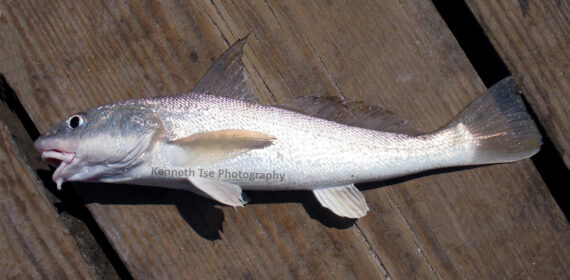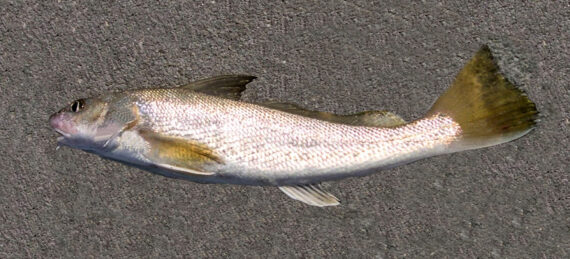Southern Kingfish, Menticirrhus americanus
 Southern Kingfish, Menticirrhus americanus. Fish caught off the Sanibel Island Pier, Sanibel Island, Florida, April 2011. Length: 25 cm (10 inches). Catch, photograph and identification courtesy of Kenneth Tse, Toronto, Ontario, Canada.
Southern Kingfish, Menticirrhus americanus. Fish caught off the Sanibel Island Pier, Sanibel Island, Florida, April 2011. Length: 25 cm (10 inches). Catch, photograph and identification courtesy of Kenneth Tse, Toronto, Ontario, Canada.
 Southern Kingfish, Menticirrhus americanus. Fish caught off the Dunedin Causeway, Dunedin, Florida, March 2016. Length: 36 cm (14 inches). Catch, photograph and identification courtesy of Ryan Crutchfield, Tampa, Florida.
Southern Kingfish, Menticirrhus americanus. Fish caught off the Dunedin Causeway, Dunedin, Florida, March 2016. Length: 36 cm (14 inches). Catch, photograph and identification courtesy of Ryan Crutchfield, Tampa, Florida.
The Southern Kingfish, Menticirrhus americanus, is a member of the Croaker or Sciaenidae Family, that is also known as the Southern King Croaker and in Mexico as berragato zorro. Globally, there are nine members in the genus Menticirrhus, of which eight are found in Mexican waters, three in the Atlantic and five in the Pacific Ocean.
The Southern Kingfish has a slender elongated body with a flat underside and a rounded cross-section. They have an overall silvery-gray coloration with a golden sheen and transition to pale gray ventrally. Most fish have 7 or 8 broad slanting dark bands on their back. Males and females have a similar appearance. Their head is long with an overhanging conical snout that projects beyond a horizontal mouth. They have a short thick barbel under their chin. Their anal fin has one spine and 7 or 8 rays; their caudal fin has a concave upper lobe and a rounded lower lobe; their first dorsal fin is triangular in shape and has 10 spines, a deep notch, and their second dorsal fin has 1 spine and 22 to 25 rays; and their pectoral fins are large and pointed. They have 10 short knobby gill rakers that virtually disappear in larger fish. They are covered with rough scales. Their lateral line extends to the end of the caudal fin.
The Southern Kingfish is a demersal species that is found over sandy bottoms along the shore, in the surf zone, and in inshore bays at depths up to 107 m (350 feet). They are small in stature reaching a maximum of 50 cm (20 inches) in length and just over 1.0 kg (2 lbs 3 oz) in weight. They are a euryhaline and eurythermal species capable of tolerating a wide range of temperatures and salinities. Juveniles are found in estuaries with very low salinity levels. They are found inshore during the summer months and in deeper waters when the coastal waters cool. They feed primarily on benthic invertebrates, including shrimps and other small crustaceans. They also eat amphipods, polychaete worms, mollusks, and small fish. Their chin barbel is used to locate prey on the bottom. Larvae feed on zooplankton. Reproduction is via batch spawning which occurs every seven days during the summer months. They have a lifespan of up to six years.
The Southern Kingfish is a resident of all Mexican waters of the Atlantic Ocean including the Gulf of Mexico and the Caribbean.
The Southern Kingfish can be easily confused with the Gulf Kingfish, Menticirrhus littoralis (plain silver color; short pectoral fins) and the Northern Kingfish, Menticirrhus saxatilis (5 or 6 oblique bars; dark stripe under lateral line; 8 anal fin rays).
From a conservation perspective the Southern Kingfish is currently considered to be of Least Concern with stable, widely distributed populations. They are a common and popular fish for recreational anglers being caught from piers and beaches along the southeast United States. They are a target if commercial fishermen with the majority of fish originating as a by-catch of shrimp trawls. They are considered to be excellent table fare.